Annotated Bibliography: History of Slavery and Contemporary Society
VerifiedAdded on 2023/06/09
|7
|1476
|399
Annotated Bibliography
AI Summary
This annotated bibliography examines the multifaceted and enduring legacy of slavery, exploring its impact on contemporary society through a selection of scholarly articles. The bibliography begins with an introduction that highlights the persistence of slavery in various forms despite its legal abolition in the 19th century, focusing on discrimination based on race and pigmentation. The included articles cover a range of topics, including the political legacy of American slavery, the impact of slavery on supply chains, the drivers of human trafficking in Europe, efforts to combat modern-day slavery at the state level, and the modern form of debt bondage. Each entry provides a summary of the article's key arguments, methodologies, and findings, offering insights into the ways in which slavery continues to shape political attitudes, economic systems, and social structures. The bibliography concludes by synthesizing the key themes and arguments presented in the selected articles, highlighting the continued relevance of slavery in the modern world. The assignment reflects the ongoing impact of slavery on contemporary society, emphasizing the need for continued research and action to address its lasting effects.
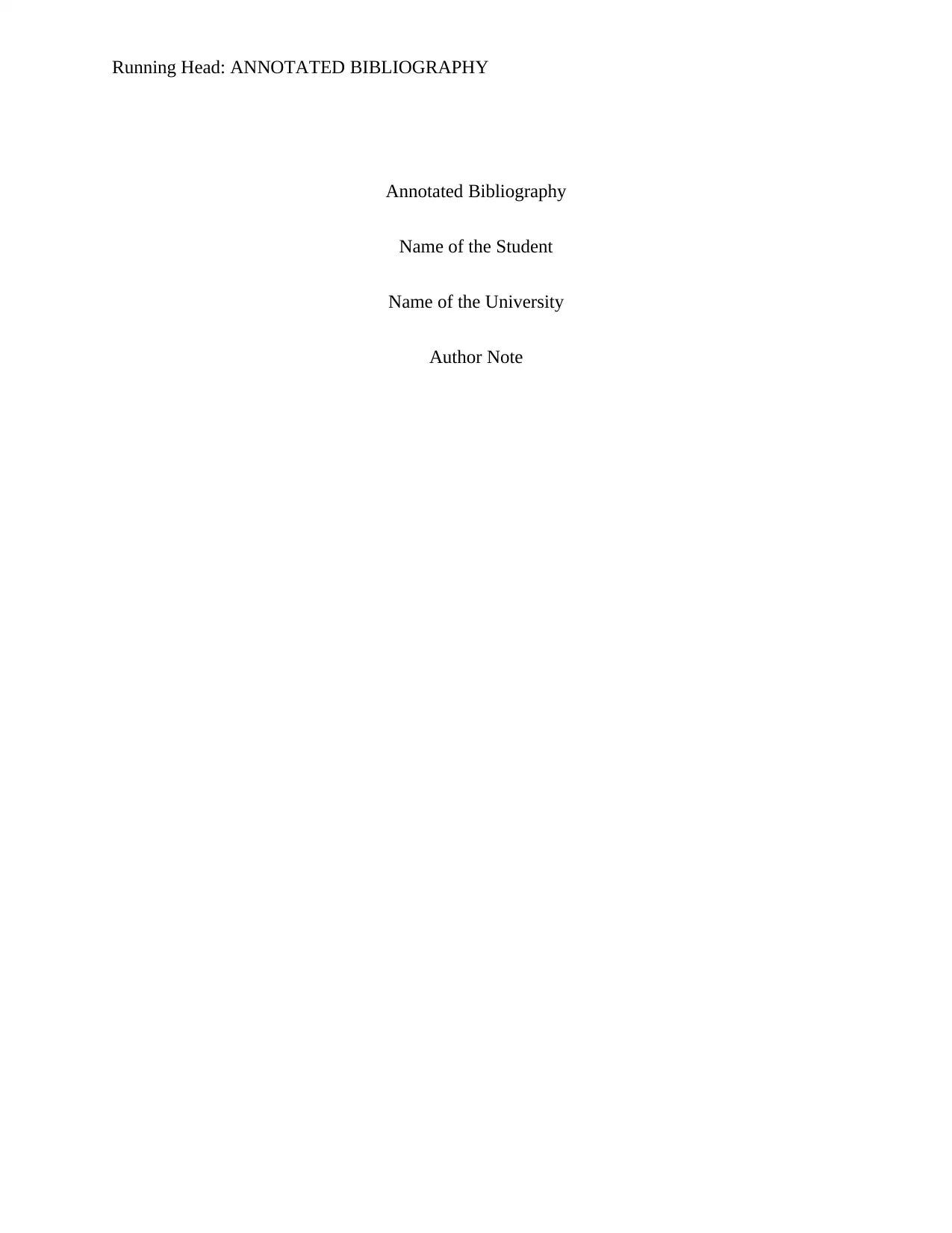
Running Head: ANNOTATED BIBLIOGRAPHY
Annotated Bibliography
Name of the Student
Name of the University
Author Note
Annotated Bibliography
Name of the Student
Name of the University
Author Note
Paraphrase This Document
Need a fresh take? Get an instant paraphrase of this document with our AI Paraphraser
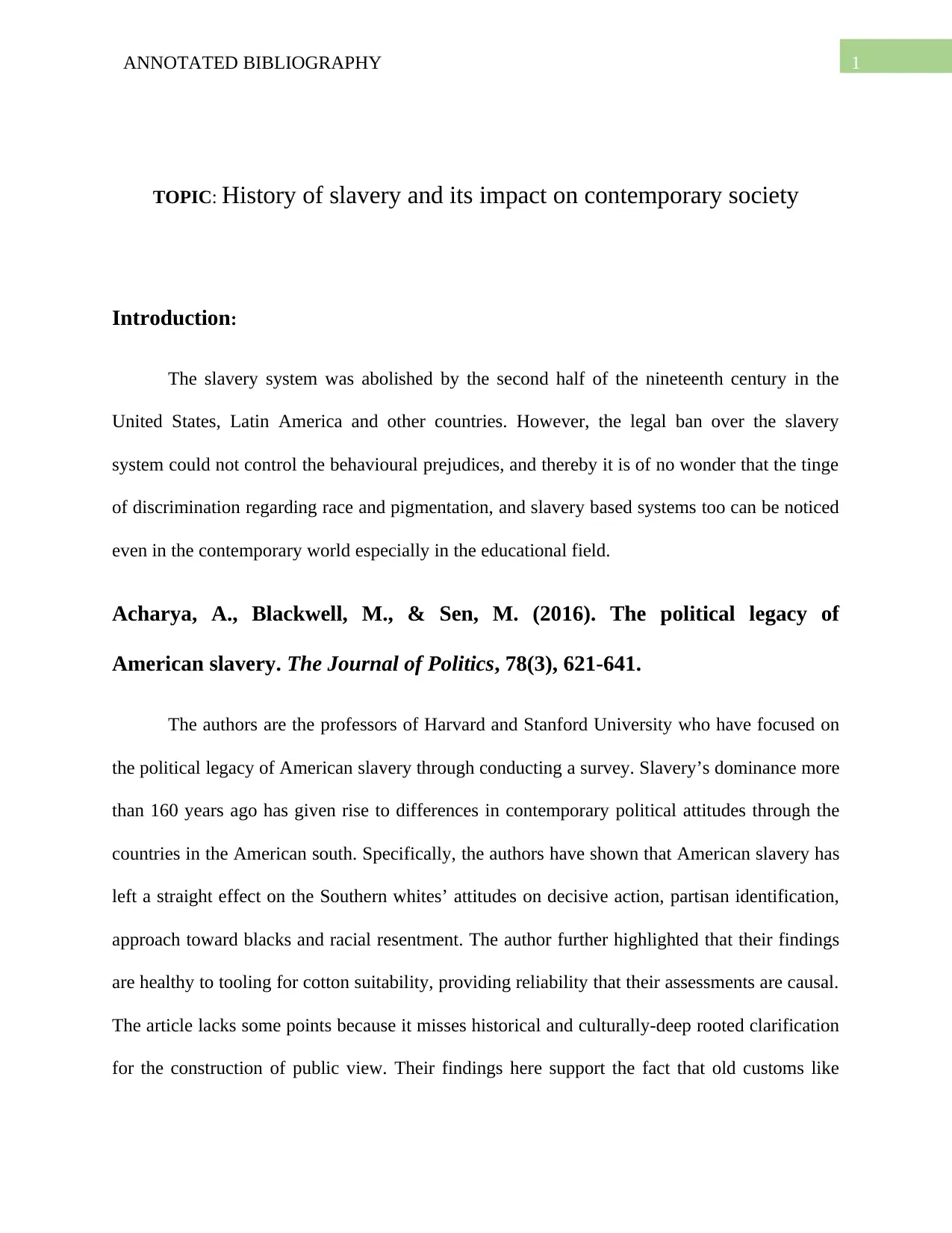
1ANNOTATED BIBLIOGRAPHY
TOPIC: History of slavery and its impact on contemporary society
Introduction:
The slavery system was abolished by the second half of the nineteenth century in the
United States, Latin America and other countries. However, the legal ban over the slavery
system could not control the behavioural prejudices, and thereby it is of no wonder that the tinge
of discrimination regarding race and pigmentation, and slavery based systems too can be noticed
even in the contemporary world especially in the educational field.
Acharya, A., Blackwell, M., & Sen, M. (2016). The political legacy of
American slavery. The Journal of Politics, 78(3), 621-641.
The authors are the professors of Harvard and Stanford University who have focused on
the political legacy of American slavery through conducting a survey. Slavery’s dominance more
than 160 years ago has given rise to differences in contemporary political attitudes through the
countries in the American south. Specifically, the authors have shown that American slavery has
left a straight effect on the Southern whites’ attitudes on decisive action, partisan identification,
approach toward blacks and racial resentment. The author further highlighted that their findings
are healthy to tooling for cotton suitability, providing reliability that their assessments are causal.
The article lacks some points because it misses historical and culturally-deep rooted clarification
for the construction of public view. Their findings here support the fact that old customs like
TOPIC: History of slavery and its impact on contemporary society
Introduction:
The slavery system was abolished by the second half of the nineteenth century in the
United States, Latin America and other countries. However, the legal ban over the slavery
system could not control the behavioural prejudices, and thereby it is of no wonder that the tinge
of discrimination regarding race and pigmentation, and slavery based systems too can be noticed
even in the contemporary world especially in the educational field.
Acharya, A., Blackwell, M., & Sen, M. (2016). The political legacy of
American slavery. The Journal of Politics, 78(3), 621-641.
The authors are the professors of Harvard and Stanford University who have focused on
the political legacy of American slavery through conducting a survey. Slavery’s dominance more
than 160 years ago has given rise to differences in contemporary political attitudes through the
countries in the American south. Specifically, the authors have shown that American slavery has
left a straight effect on the Southern whites’ attitudes on decisive action, partisan identification,
approach toward blacks and racial resentment. The author further highlighted that their findings
are healthy to tooling for cotton suitability, providing reliability that their assessments are causal.
The article lacks some points because it misses historical and culturally-deep rooted clarification
for the construction of public view. Their findings here support the fact that old customs like

2ANNOTATED BIBLIOGRAPHY
slavery are essential in giving shape to American politics and culture, even after a century of its
abolition. In this light, by examining other relationships between contemporary attitudes and
historical forces, the sphere of political conduct could be modified.
New, S. J. (2015). Modern slavery and the supply chain: the limits of
corporate social responsibility?. Supply Chain Management: An International
Journal, 20(6), 697-707.
In this paper, the author who is a professor of Hertford College & Saïd Business School,
(University of Oxford) shows that the supply chains are also profoundly affected by the slavery
systems and the issue challenges the traditional practice and thinking in Corporate Social
Responsibility (CSR). An instance of pressurised labour in UK farming has been used to serve as
a critique of such approaches. The forced labour in the supply chain has become a serious issue
these days; examples have been given of Malaysian electronic sector and Thai food industry.
Approximates of the scale problem may be different for different cases but the core issue
remains the same. The article says that this is a huge challenge for business firms, including both
reputational and ethical difficulties. The downside of this article is that the author need to
concentrate less on the advocated policies of single corporations, and extra on the sanctioned
practices and procedures. The article is highly supportive in denoting possible differences
between CSR issues and modern slavery.
slavery are essential in giving shape to American politics and culture, even after a century of its
abolition. In this light, by examining other relationships between contemporary attitudes and
historical forces, the sphere of political conduct could be modified.
New, S. J. (2015). Modern slavery and the supply chain: the limits of
corporate social responsibility?. Supply Chain Management: An International
Journal, 20(6), 697-707.
In this paper, the author who is a professor of Hertford College & Saïd Business School,
(University of Oxford) shows that the supply chains are also profoundly affected by the slavery
systems and the issue challenges the traditional practice and thinking in Corporate Social
Responsibility (CSR). An instance of pressurised labour in UK farming has been used to serve as
a critique of such approaches. The forced labour in the supply chain has become a serious issue
these days; examples have been given of Malaysian electronic sector and Thai food industry.
Approximates of the scale problem may be different for different cases but the core issue
remains the same. The article says that this is a huge challenge for business firms, including both
reputational and ethical difficulties. The downside of this article is that the author need to
concentrate less on the advocated policies of single corporations, and extra on the sanctioned
practices and procedures. The article is highly supportive in denoting possible differences
between CSR issues and modern slavery.
⊘ This is a preview!⊘
Do you want full access?
Subscribe today to unlock all pages.

Trusted by 1+ million students worldwide
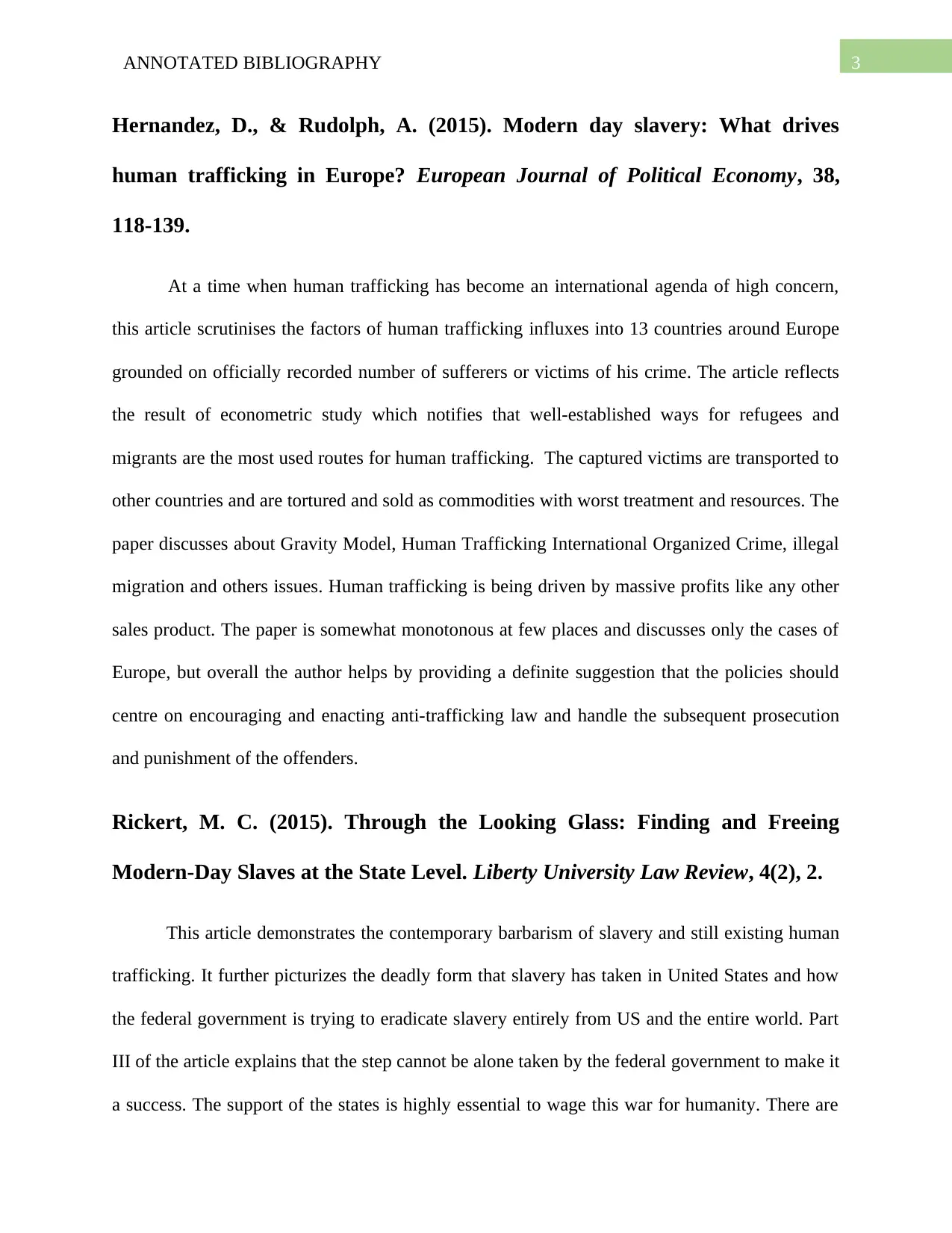
3ANNOTATED BIBLIOGRAPHY
Hernandez, D., & Rudolph, A. (2015). Modern day slavery: What drives
human trafficking in Europe? European Journal of Political Economy, 38,
118-139.
At a time when human trafficking has become an international agenda of high concern,
this article scrutinises the factors of human trafficking influxes into 13 countries around Europe
grounded on officially recorded number of sufferers or victims of his crime. The article reflects
the result of econometric study which notifies that well-established ways for refugees and
migrants are the most used routes for human trafficking. The captured victims are transported to
other countries and are tortured and sold as commodities with worst treatment and resources. The
paper discusses about Gravity Model, Human Trafficking International Organized Crime, illegal
migration and others issues. Human trafficking is being driven by massive profits like any other
sales product. The paper is somewhat monotonous at few places and discusses only the cases of
Europe, but overall the author helps by providing a definite suggestion that the policies should
centre on encouraging and enacting anti-trafficking law and handle the subsequent prosecution
and punishment of the offenders.
Rickert, M. C. (2015). Through the Looking Glass: Finding and Freeing
Modern-Day Slaves at the State Level. Liberty University Law Review, 4(2), 2.
This article demonstrates the contemporary barbarism of slavery and still existing human
trafficking. It further picturizes the deadly form that slavery has taken in United States and how
the federal government is trying to eradicate slavery entirely from US and the entire world. Part
III of the article explains that the step cannot be alone taken by the federal government to make it
a success. The support of the states is highly essential to wage this war for humanity. There are
Hernandez, D., & Rudolph, A. (2015). Modern day slavery: What drives
human trafficking in Europe? European Journal of Political Economy, 38,
118-139.
At a time when human trafficking has become an international agenda of high concern,
this article scrutinises the factors of human trafficking influxes into 13 countries around Europe
grounded on officially recorded number of sufferers or victims of his crime. The article reflects
the result of econometric study which notifies that well-established ways for refugees and
migrants are the most used routes for human trafficking. The captured victims are transported to
other countries and are tortured and sold as commodities with worst treatment and resources. The
paper discusses about Gravity Model, Human Trafficking International Organized Crime, illegal
migration and others issues. Human trafficking is being driven by massive profits like any other
sales product. The paper is somewhat monotonous at few places and discusses only the cases of
Europe, but overall the author helps by providing a definite suggestion that the policies should
centre on encouraging and enacting anti-trafficking law and handle the subsequent prosecution
and punishment of the offenders.
Rickert, M. C. (2015). Through the Looking Glass: Finding and Freeing
Modern-Day Slaves at the State Level. Liberty University Law Review, 4(2), 2.
This article demonstrates the contemporary barbarism of slavery and still existing human
trafficking. It further picturizes the deadly form that slavery has taken in United States and how
the federal government is trying to eradicate slavery entirely from US and the entire world. Part
III of the article explains that the step cannot be alone taken by the federal government to make it
a success. The support of the states is highly essential to wage this war for humanity. There are
Paraphrase This Document
Need a fresh take? Get an instant paraphrase of this document with our AI Paraphraser
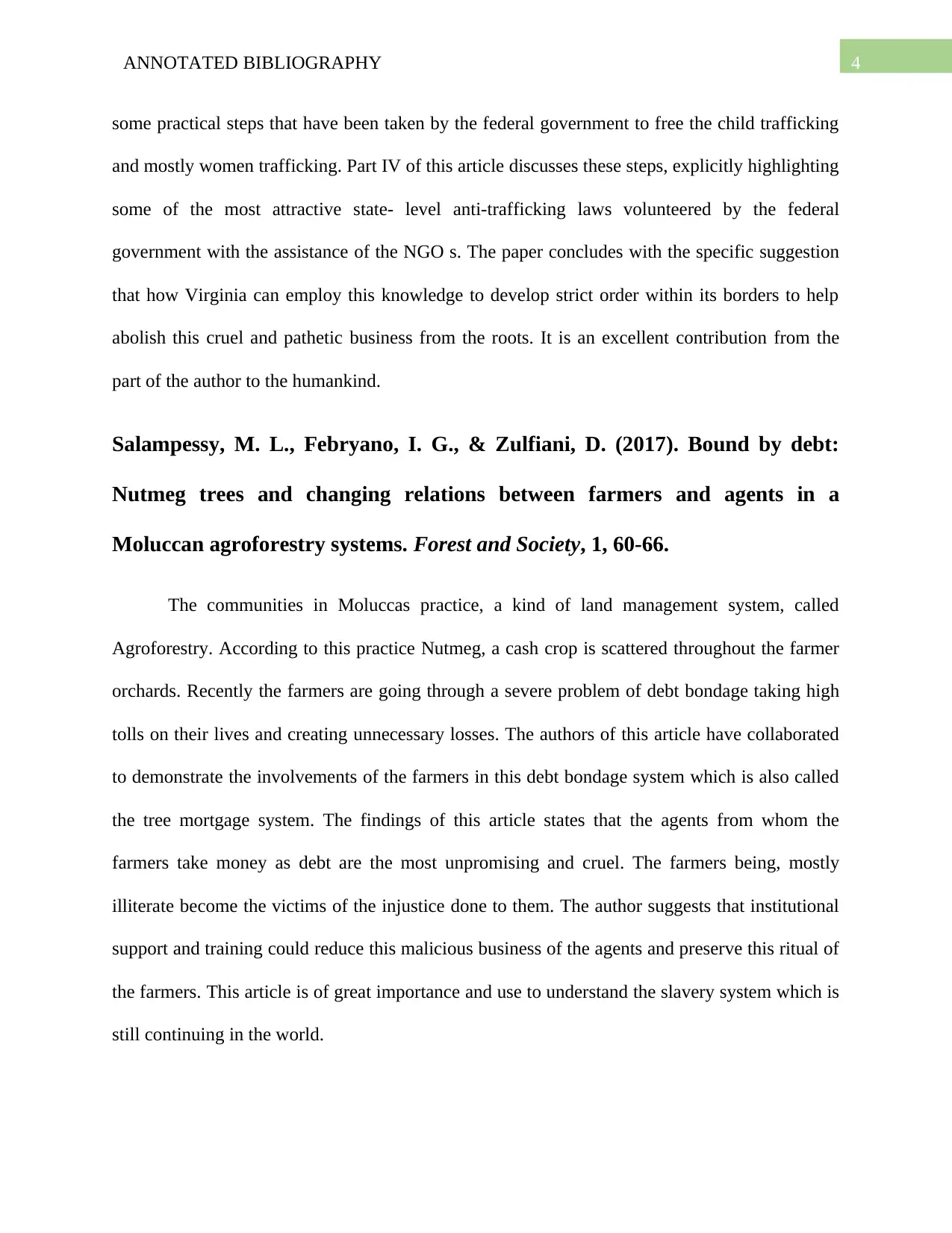
4ANNOTATED BIBLIOGRAPHY
some practical steps that have been taken by the federal government to free the child trafficking
and mostly women trafficking. Part IV of this article discusses these steps, explicitly highlighting
some of the most attractive state- level anti-trafficking laws volunteered by the federal
government with the assistance of the NGO s. The paper concludes with the specific suggestion
that how Virginia can employ this knowledge to develop strict order within its borders to help
abolish this cruel and pathetic business from the roots. It is an excellent contribution from the
part of the author to the humankind.
Salampessy, M. L., Febryano, I. G., & Zulfiani, D. (2017). Bound by debt:
Nutmeg trees and changing relations between farmers and agents in a
Moluccan agroforestry systems. Forest and Society, 1, 60-66.
The communities in Moluccas practice, a kind of land management system, called
Agroforestry. According to this practice Nutmeg, a cash crop is scattered throughout the farmer
orchards. Recently the farmers are going through a severe problem of debt bondage taking high
tolls on their lives and creating unnecessary losses. The authors of this article have collaborated
to demonstrate the involvements of the farmers in this debt bondage system which is also called
the tree mortgage system. The findings of this article states that the agents from whom the
farmers take money as debt are the most unpromising and cruel. The farmers being, mostly
illiterate become the victims of the injustice done to them. The author suggests that institutional
support and training could reduce this malicious business of the agents and preserve this ritual of
the farmers. This article is of great importance and use to understand the slavery system which is
still continuing in the world.
some practical steps that have been taken by the federal government to free the child trafficking
and mostly women trafficking. Part IV of this article discusses these steps, explicitly highlighting
some of the most attractive state- level anti-trafficking laws volunteered by the federal
government with the assistance of the NGO s. The paper concludes with the specific suggestion
that how Virginia can employ this knowledge to develop strict order within its borders to help
abolish this cruel and pathetic business from the roots. It is an excellent contribution from the
part of the author to the humankind.
Salampessy, M. L., Febryano, I. G., & Zulfiani, D. (2017). Bound by debt:
Nutmeg trees and changing relations between farmers and agents in a
Moluccan agroforestry systems. Forest and Society, 1, 60-66.
The communities in Moluccas practice, a kind of land management system, called
Agroforestry. According to this practice Nutmeg, a cash crop is scattered throughout the farmer
orchards. Recently the farmers are going through a severe problem of debt bondage taking high
tolls on their lives and creating unnecessary losses. The authors of this article have collaborated
to demonstrate the involvements of the farmers in this debt bondage system which is also called
the tree mortgage system. The findings of this article states that the agents from whom the
farmers take money as debt are the most unpromising and cruel. The farmers being, mostly
illiterate become the victims of the injustice done to them. The author suggests that institutional
support and training could reduce this malicious business of the agents and preserve this ritual of
the farmers. This article is of great importance and use to understand the slavery system which is
still continuing in the world.
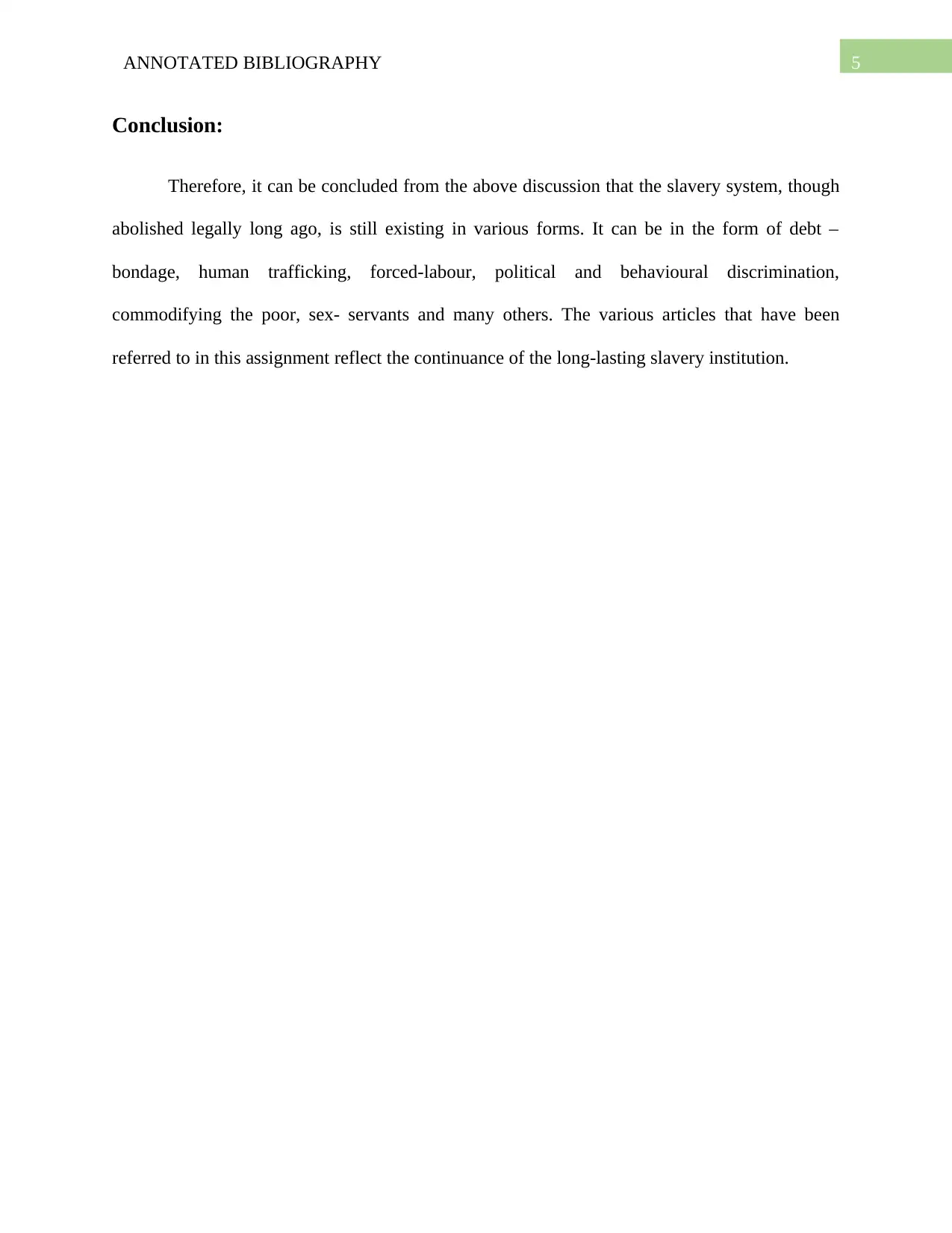
5ANNOTATED BIBLIOGRAPHY
Conclusion:
Therefore, it can be concluded from the above discussion that the slavery system, though
abolished legally long ago, is still existing in various forms. It can be in the form of debt –
bondage, human trafficking, forced-labour, political and behavioural discrimination,
commodifying the poor, sex- servants and many others. The various articles that have been
referred to in this assignment reflect the continuance of the long-lasting slavery institution.
Conclusion:
Therefore, it can be concluded from the above discussion that the slavery system, though
abolished legally long ago, is still existing in various forms. It can be in the form of debt –
bondage, human trafficking, forced-labour, political and behavioural discrimination,
commodifying the poor, sex- servants and many others. The various articles that have been
referred to in this assignment reflect the continuance of the long-lasting slavery institution.
⊘ This is a preview!⊘
Do you want full access?
Subscribe today to unlock all pages.

Trusted by 1+ million students worldwide

6ANNOTATED BIBLIOGRAPHY
Bibliography:
Acharya, A., Blackwell, M., & Sen, M. (2016). The political legacy of American slavery. The
Journal of Politics, 78(3), 621-641.
Hernandez, D., & Rudolph, A. (2015). Modern day slavery: What drives human trafficking in
Europe? European Journal of Political Economy, 38, 118-139.
New, S. J. (2015). Modern slavery and the supply chain: the limits of corporate social
responsibility?. Supply Chain Management: An International Journal, 20(6), 697-707.
Rickert, M. C. (2015). Through the Looking Glass: Finding and Freeing Modern-Day Slaves at
the State Level. Liberty University Law Review, 4(2), 2.
Salampessy, M. L., Febryano, I. G., & Zulfiani, D. (2017). Bound by debt: Nutmeg trees and
changing relations between farmers and agents in a Moluccan agroforestry systems.
Forest and Society, 1, 60-66.
Bibliography:
Acharya, A., Blackwell, M., & Sen, M. (2016). The political legacy of American slavery. The
Journal of Politics, 78(3), 621-641.
Hernandez, D., & Rudolph, A. (2015). Modern day slavery: What drives human trafficking in
Europe? European Journal of Political Economy, 38, 118-139.
New, S. J. (2015). Modern slavery and the supply chain: the limits of corporate social
responsibility?. Supply Chain Management: An International Journal, 20(6), 697-707.
Rickert, M. C. (2015). Through the Looking Glass: Finding and Freeing Modern-Day Slaves at
the State Level. Liberty University Law Review, 4(2), 2.
Salampessy, M. L., Febryano, I. G., & Zulfiani, D. (2017). Bound by debt: Nutmeg trees and
changing relations between farmers and agents in a Moluccan agroforestry systems.
Forest and Society, 1, 60-66.
1 out of 7
Related Documents
Your All-in-One AI-Powered Toolkit for Academic Success.
+13062052269
info@desklib.com
Available 24*7 on WhatsApp / Email
![[object Object]](/_next/static/media/star-bottom.7253800d.svg)
Unlock your academic potential
Copyright © 2020–2025 A2Z Services. All Rights Reserved. Developed and managed by ZUCOL.




